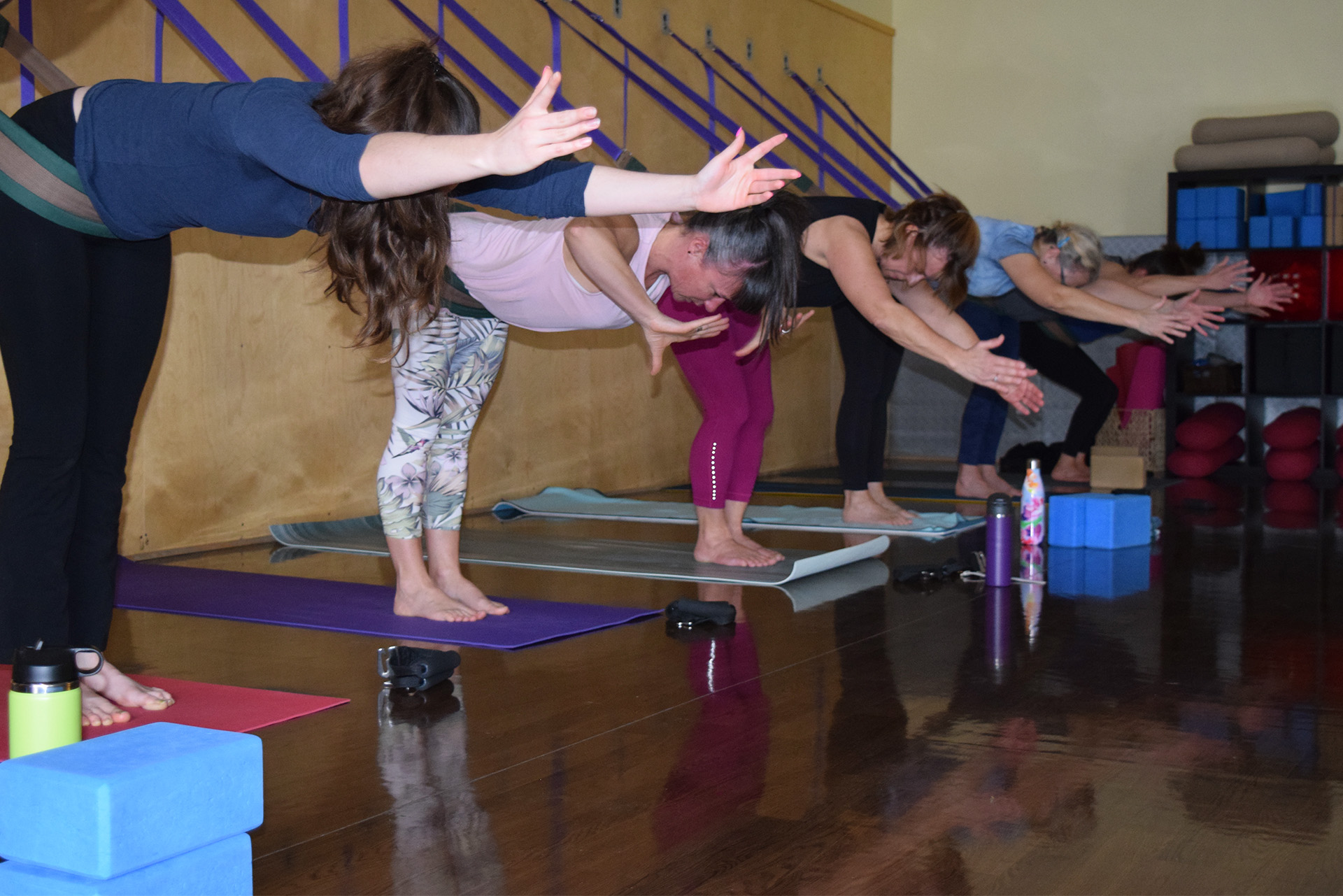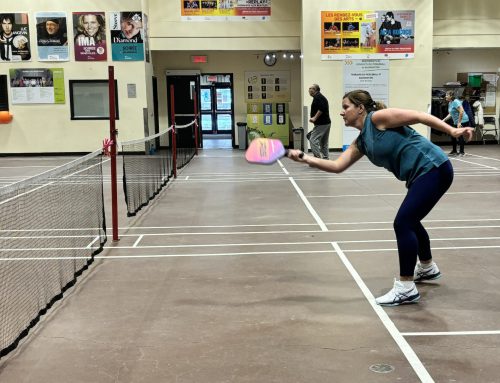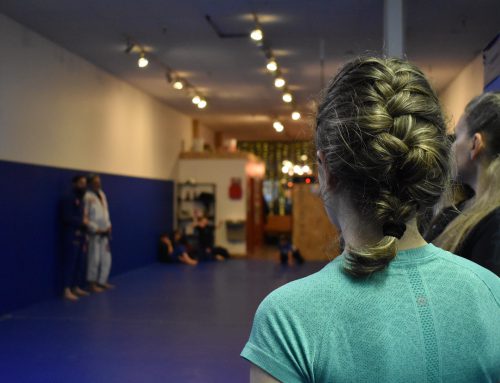BY Emily Palmer & Esme Bale
“It looks scary, but it’s not,” says Helena Scheffer, a student in the wall yoga class at Sattva Yoga Beaconsfield.
Wall yoga incorporates the use of a hammock to help yogis deepen traditional yoga poses. The hammock is attached to two straps that are secured to the wall by brackets.
“I’ve done all kinds of stuff I didn’t think I could do,” Scheffer says.
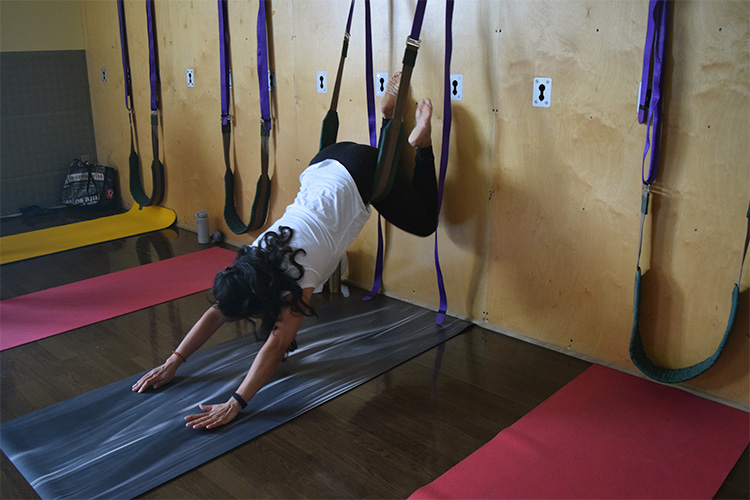
Woman warms up with the straps. Photo by Esme Bale.
“It’s like having a friend help you,” explains Linda Marchand, a wall yoga instructor at Sattva.
Wall yoga involves working with and against gravity. The use of the hammock allows you to hold poses in the air while engaging the core.
“When it requires strength, it requires quite a bit of strength,” she says.
Alternatively, you can lean into the hammock and release.
“It’s a nice opportunity actually for people that aren’t flexible to maybe create that space and length in the joints,” explains Marchand.
Sattva has been offering wall yoga classes for almost a decade. There are only a few other yoga studios that offer wall yoga classes in Montreal, most notably Naada Yoga in the Mile End and Modo Yoga in the West Island. It remains quite niche due to its financial and space restrictions in installing a wall suited for the practice.
Sattva can only accommodate eight students each wall yoga class, compared to the twenty-two students in more traditional yoga classes. They currently offer one wall yoga class per week.
“I think that it takes a little bit of courage to walk through the door and do your first wall yoga class, but once you do, most people are hooked,” says Marchand.
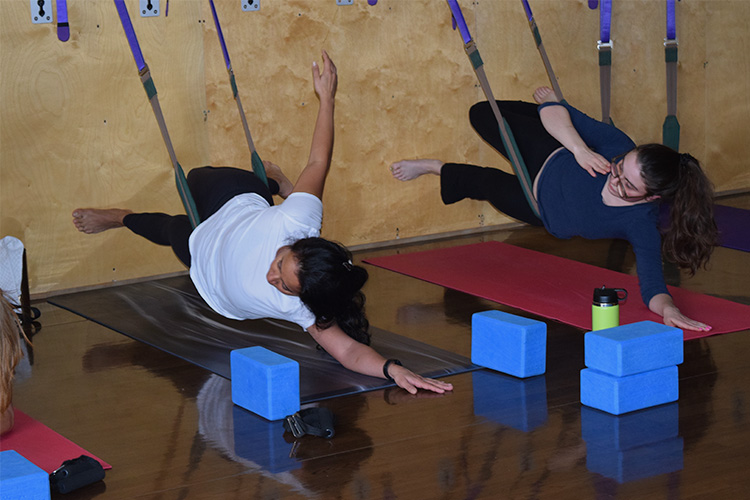
Students hang a few inches off the ground with the support of the straps. Photo by Emily Palmer.
Wall yoga is one of many alternative fitness classes offered in the city. If Montrealers are struggling to find the motivation to go to the gym, there are more non-traditional routes available for exercise.
According to the Canadian 24-Hour Movement Guidelines, adults should do 150 minutes of moderate to vigorous physical activity per week.
“You don’t have to come to the gym to lift weights,” says athletic therapist Pierre Tobjian.
Tobjian says it’s possible to supplement a more traditional workout routine with alternative forms of fitness.
“As long as you’re going out there and you’re moving and you’re being physically active, I think it’s fine. You don’t have to come to the gym to lift,” he says.
Other than wall yoga classes, Montrealers can consider taking aerial classes, burlesque classes, or pole dancing classes.
Pole fitness has established itself as a legitimate mode of exercise, shedding stereotypes and its stigma as a sexualised practice. Video by Emily Palmer.
Alissa Bonneville started her business Studio CirQus ten years ago when she noticed a lack of recreational classes in Montreal’s circus hub. She encourages adult beginners to give recreational circus classes a try.
“It’s important for me to push people to be mentally open and spiritually open to get rid of their limitations,” explains Bonneville.
The aerial arts involve a physical activity that is performed on an apparatus that hangs from a rig. Bonneville specializes in aerial silks, but also teaches aerial hammock, aerial hoop, and aerial trapeze.
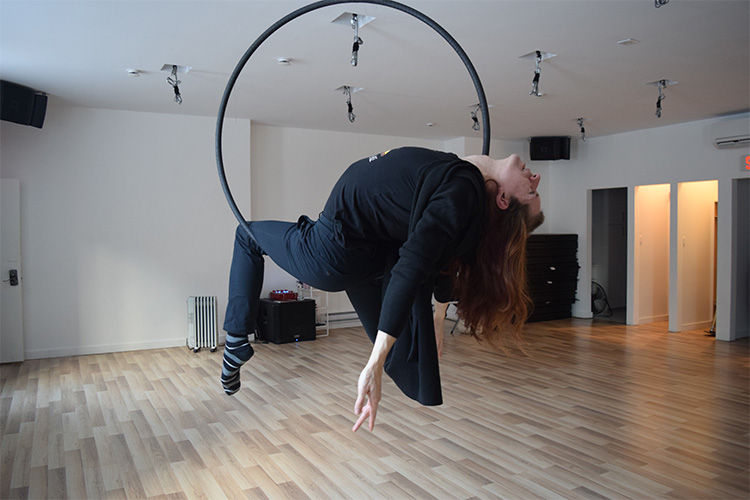
Corey Tomicic leans back into the aerial hoop. Photo by Esme Bale.
“You’re going to love hanging upside down. You’re going to love the flexibility training. You’re going to love realizing that you don’t actually need upper body strength like weightlifters. You actually need to manipulate your silks and the different apparatuses with your legs like a little monkey,” Bonneville says.
She suggests trying an aerial class if you’re bored of your regular fitness routine. Much like wall yoga, aerial classes require a lot of strength. By practicing inversions on silks or hoops, you’re activating the abs.
“All of a sudden you’re going to be super fit and you don’t realize why because every time that you come to take a class with me you’re having so much fun. You’re not even realizing that you’re exercising,” says Bonneville.
Corey Tomicic, an aerial artist who teaches at both Milan Pole Montreal and La Caserne, prioritizes making a safe environment for beginners to explore.
“There is a need for comfort,” Tomicic says.
If there are any beginners in the class, Tomicic carefully explains how to get on and off the apparatus so that everyone has an escape route.
In his hoop class, he is all for taking it slowly. He has students connect with the hoop before attempting any movement.
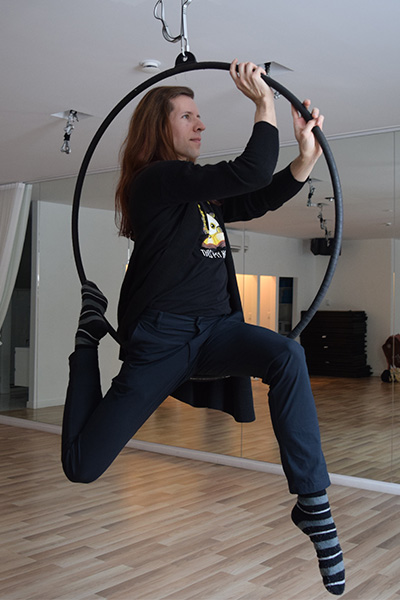
Corey Tomicic sits up in the aerial hoop. Photo by Esme Bale.
“If I can let myself kind of relax a bit more into the hoop then I can connect with it better. So then even if it moves, I move with it,” he says.
Once his students feel familiar with just sitting in the hoop itself, Tomicic starts to softly build movement into the practice.
“From uncomfort you can always come back and retain that feeling,” he says.
“It’s very important as well if you have the right instructor to teach you the basics first to build that skill and improve it and do it in a safe manner,” advises Tobjian.
Roxy Torpedo teaches burlesque classes at Montreal’s only burlesque academy, Arabesque Burlesque, including “Intro to Burlesque”.
While burlesque may not be as physically demanding as aerial, its risqué undertones involving dancing, strip-teasing, and theatrical elements can intimidate people.
“I go into it with the idea of discovering burlesque archetypes,” Torpedo says about her approach to intro classes.
Where you can find alternative fitness classes in Montreal. Map by Esme Bale.
Within the burlesque world, there are archetypes students can tap into while performing, such as the pin-up, the femme fatale, and the diva.
“We get into introducing these characters and that brings us to learning about dance movements, attitude, walks, and heels,” she says.
The goal is for students to eventually be able to create their own burlesque persona.
“A lot of people do this because they want to feel better about themselves,” she says. “There’s a lot of people that approach this with some sort of therapeutic journey behind it.”
Emilie-Claude St-Amour Maillé found the process of starting burlesque classes two and a half years ago very emotional.
“I’m going to learn about myself,” she says she realized during her first few classes.
She has since gained a lot of self-confidence and is grateful for Torpedo and other members of the burlesque community for giving her that space.
“There’s people that are interested in the fact that it’s sex positive and queer,” Torpedo says.
The community is welcoming to all body types and identities.
“I think that we all have in our minds that we want to make it accessible, fun, and considerate of how everyone can move,” Torpedo says.
Athletic therapist Tobjian encourages people to get exercise in whatever way works for them.
“If you’re doing burlesque or pole dancing or any of those exercises and you’re moving and you’re using your core muscles, you’re using your upper body, your lower body, it’s definitely beneficial,” he says.
